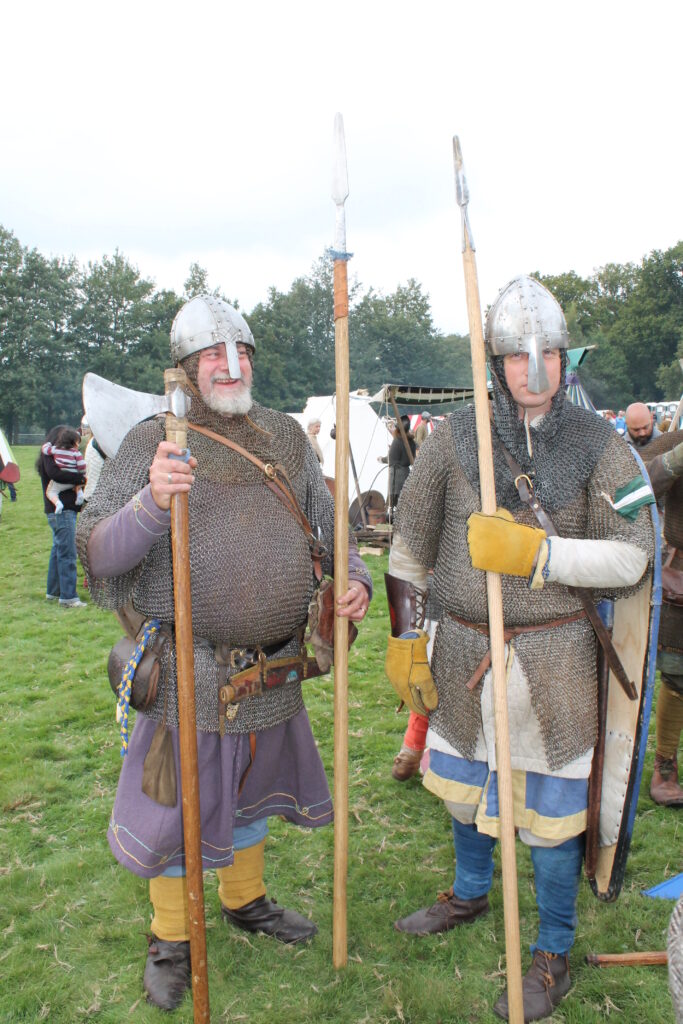Arms and the Housecarl

Arms and the man – the weapons and armour that made the housecarl the most feared footsoldier of late Anglo-Saxon England.
Helmet
According to the Bayeaux Tapestry, the Norman-style helmet was common to both armies at the Battle of Hastings. Only elite warriors wore metal helmets. The noseguard provided a degree of facial protection without compromising vision.
Mail coif
Mail was expensive. A mail coif protected the head, neck and shoulders; together with a helmet and the hauberk it provided great protection to the housecarl’s upper body.
Mail hauberk
Mail was one of the best gifts a housecarl might receive from his lord. If a mail-clad warrior fell in battle, there would be a great struggle to strip the armour from the body. Mail provided effective protection against slashes or thrusts from swords or spears, although clubs could cause trauma without penetrating the armour.
Gambeson
Housecarls wore a padded, quilted jacket under the mail. This cushioned against blows from blunt weapons such as maces and warhammers, as well as providing a further layer of protection against edged weapons. Poorer warriors relied on just this padded jacket for defence.
Greaves
Although archaeological exhumations have shown that leg wounds were fairly common among warriors of this era, greaves were very rare. Some warriors may have used leather ‘puttees’ to protect their calves.
Gloves
Thick, leather gloves were worn, but there is no record of more heavy-duty protection for the hands.
Vambraces
Some warriors may have used leather vambraces to protect their forearms.
Shield
The typical Anglo-Saxon shield was round, with a central boss, and made of lime, alder or poplar – light woods which are resistant to splitting. By the eleventh century, the teardrop shaped shield had also become widespread. It provided greater whole body protection and, because it could more easily be jammed into the ground, it allowed housecarls to stand behind it while using the two-handed Dane axe.
Spear
The ubiquitous weapon of the era. Indeed, the mark of a free man was being allowed to carry a spear – slaves could not. Spears were the ideal weapon in the shield wall, as they kept the enemy at distance while allowing the warrior to thrust at exposed areas. Some spears had small projections, or wings, which were used to hook and pull an enemy’s shield out of position. Spears were usually used over arm, aiming at the enemy’s face.
Javelins
At the start of a battle there was an exchange of javelins, with the men at the rear of the shieldwall launching missiles at the enemy. A well-thrown javelin could penetrate a shield. Even if it did not, a spear embedded into a shield would drag the shield downward by its weight, exposing the man holding it to further attack.
Seax
The very name, Saxon, derives from ‘seax’, the all-purpose knife worn at the waist by Anglo-Saxons. It was a single-edged weapon, worn horizontally in a scabbard on the waist, with the edge pointing upwards. Generally too small to cause much damage in combat, it could have been used to finish off a prone enemy.
Sword
The most high-status of weapons but one that was probably not so effective in a shieldwall – it would only really come into play when a shieldwall broke and the battle turned into a general melée or a rout.
Dane axe
The two-handed axe was popularised in England by Cnut and his men, so much so that in the fifty years between the Danish and Norman conquests, it became the preferred weapon of the English housecarls.
0 Comments